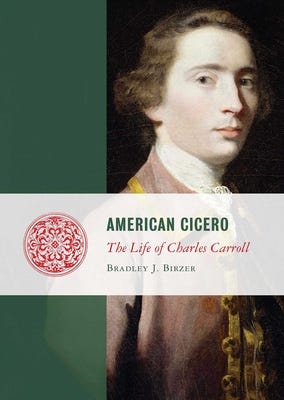When Charles Carroll of Carrollton—the last of the signers of the Declaration of Independence—departed this world at the age of 95, in November 1832, newspapers across the country lamented, “A Great Man Hath Fallen in Israel,” and “The Last of the Romans” has died. The modern reader must ask, in some confusion, about the seemingly incoherent bequeathing of titles from various times and peoples and religions. Did the Americans of 1832 think Carroll a Hebrew prophet, a classical demigod, or the last defender of the Roman republic? To the American of 1832, however, there was nothing inconsistent in giving all three titles to one of the signers of the Declaration. America, herself, was the product of Judeo-Christian as well as the Greco-Roman and Anglo-Saxon traditions. Of course, one of her greatest leaders would embody all aspects of our inheritance.
We moderns and postmoderns find this confusing not because of the failures or oddities of the Americans of 1832 but because of our own loss of education and imagination. In other words, the failure is our own, and we continue to misunderstand, mock, or ignore our profound Judeo-Christian and Classical heritage at our own peril as a people, a republic, and a nation.
Most of the leaders during the founding generation, 1761-1793, had received a liberal education. Indeed, they would have been perplexed at the idea of modifying education with liberal. After all, until the late nineteenth century, all education was liberal education. Everything else was training. From the ancients on, “liberal” meant to be freed from the worries of this world, to see things that pertain to all humans in all times and all places. As such, education demanded a conversation with the Greats who would come before, connecting them not only to us and each other, but to all who had yet to come.
In the eighteenth-century American colonies, boys entered college at the age of 14. To be accepted by any of the colleges at the time, the prospective student must prove fluency (written and oral) in Greek and Latin as well as proficiency in mathematics and excellence of character. They read and translated Virgil, Homer, and St. John. They came to know the minds and the souls of each of these men, intimately. Not satisfied with merely these, many Americans also learned Italian for the sole purpose of reading Dante in the original.
A few practical and tangible examples show how pervasive classical education was. Founders wrote under the pseudonyms of Publius and Brutus, dressed in togas and orated, and even declared their upper legislative body, the Senate (Latin, for old and wise men). When they created the American government, they created a republic (Latin, for the good thing or the common good). Even on the revolutionary battlefields, the French and American allies had to communicate with one another in Latin, not knowing the native language of the other. Or, consider the actual, physical building of Congress for a moment. The architecture comes not from India, Persia, central Europe, or, most surprisingly, from England. It comes from the Roman republic. Towns, villages, and cities all across the frontier bore the names: Athens, Homer, Romulus, and Remus. And, after the Federal architecture fashionable in the 1780s and 1790s played itself out, came Greek Revival, still so obvious throughout the small towns across the upper Midwest.
Though the founding generation knew Greek history, they turned first and foremost to their republican forbearers of Rome, especially to those who came at the transition from the republic to the empire. From Cicero, they took their notions of virtue and natural law; from Virgil, their ideas of hope and heroism; from Livy, their understandings of history and decline; and from Tacitus, the sanctity of the family.
Far from being elite, liberal education was for every American who wanted (and had time for it) during the eighteenth and nineteenth centuries. In an era before mandated public schooling, common schools, tutors, and ministers educated students—at whatever age—only in the classical languages and the literary and cultural expressions of each, along with sacred scripture. An American learned “reading, writing, and arithmetic” at home, generally from reading the King James Bible and working in the fields. Schools and educators were too expensive for teaching things that should be taught at home. Formal education was not for rudimentary skills, but for classical learning.
“Should the time ever come when Latin and Greek should be banished from our universities and the study of Cicero and Demosthenes, of Homer and Virgil, should be considered as unnecessary for the formation of a scholar, we should regard mankind as fast sinking into an absolute barbarism,” the frontier newspaper, the Cincinnati Western Review argued in 1820. Without such a foundation, America would quickly sink into the “gloom of mental darkness,” increasing until a dark age became all pervasive.
At some level, it is odd that anyone need defend liberal education. Until the Grant Administration in American history, all western education was liberal education and had been since the days of Socrates. We Americans since the 1870s are the odd ones, proclaiming education that which is most certainly not education but training, not virtue but utility, and not timeless but ephemeral.




Thank you! Very accessible and readable explanation of what is meant by a liberal education. Or, a “classical” education as we now toss that label around. I think that especially useful to me will be your distinction between education and everything else which is “ training. “People will understand that. We train now, we don’t educate. Will we be able to change course? Alas, looks iffy.
I remember having to read John Dewey in graduate school and not being very impressed, even though my education professors treated him like a saint. I'm very thankful my high school required me to take 2 years of Latin - that has been some of the most useful knowledge I've ever acquired.